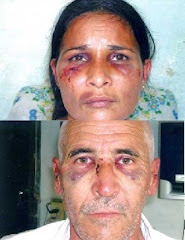By WILL WEISSERT, Associated Press Writer Will Weissert, Associated
Press Writer – 4 mins ago
HAVANA – It's Cuba's twist on "you are what you drive": Here, you are
your license plate.
A rainbow of colors and an alphabet soup of codes tell the discerning
eye how important you are in the egalitarian revolution as you whiz by —
your nationality, what you do for a living and often how high you rank
at work.
"The kind of car you drive says something," says Norberto Leon, a
retiree who collects pocket change for watching parked cars. "The
license plate, it says more."
Cuba's painstaking color-coding of license plates — a system copied from
the former Soviet Union — is one way authorities have kept tabs on
people and their vehicles for decades.
The government owns most cars. They have blue plates with letters and
numbers that indicate when and where the vehicle can operate and whether
the driver can use it for personal as well as professional reasons.
Inspectors wait along highways out of town and other high-traffic areas,
stopping official cars to check their route sheets and to make sure they
aren't being used for a jaunt to the beach.
Executives at government-run firms — who get caramel-colored plates —
have more leeway. But even they may only be allowed to use their cars to
get to and from work.
"It's a form of control," said Weichel Guera, a National Office of
Statistics chauffeur who is assigned a government sedan that he can use
only to ferry top officials during business hours. He and his Lada spend
most of their time parked outside the statistics building.
In the Soviet Union, Cuba's benefactor in many regards, all plates were
black and white, and the first two letters specified the province where
the vehicle was registered. The third letter denoted either state or
private ownership.
The Soviets also assigned numbers for embassy license plates based on a
country's recognition of the Bolshevik Revolution: Plates for Britain —
the first to accept the czar's ouster — are still 001.
In Cuba, the first letter in the license plate indicates which of 14
provinces the car hails from, such as "H" for Havana. The letter "K"
means the car is privately owned — either by a person or by a foreign firm.
Military vehicles have mint-green, rear-only plates; olive-green plates
are for vehicles issued by the Ministry of the Interior, including Fidel
Castro's fleet of armored Mercedes 280s, which were built between 1982
and 1984.
Black plates are for foreign diplomats, who don't have to adhere to
traffic laws. White-plated vehicles of Cuban government ministers or
heads of state organizations also drive as if they have diplomatic
immunity — though technically they don't.
The last three digits on diplomatic plates often denote the professional
rank of the driver. So, if you're stuck behind a gray Mercedes with
black license plate 179-004, that means the fourth most-important
officer from the Russian embassy is likely behind the wheel.
"Everyone's supposed to be equal under socialism, but when a late-model
sedan with black license plates roars down Quinta Avenida (Fifth Avenue)
in Havana, the driver is saying, 'Look out, I'm a big shot,'" said
Tracey Eaton, a U.S. journalist once posted in Havana who now writes the
blog "Along the Malecon."
For years, officials' cars were Iron-Curtain imports, as Cubans were
encouraged to drive Ladas or other boxy, smelly and slow models. Now
many official sedans are imported from China or bought from Havana's
Peugeot, Fiat and Mercedes dealerships, adding diversity to the
white-plated fleet.
Rental cars get maroon plates. Foreign journalists, religious leaders
and Cubans working for overseas firms have neon-orange ones.
Red "provisional" plates allow vehicles to circulate while authorities
sort out just what color tag they should get.
Most of the half-century-old American roadsters that create a moving
museum along the island's potholed streets have yellow license plates,
meaning they are vehicles owned by ordinary Cubans.
The holdovers from Detroit's chrome-and-tail-fin era are still prominent
on the roads because Cubans with non-VIP jobs can buy and sell only cars
manufactured before the Castros took power in 1959. Buying newer
vehicles requires government permission — including justifying how you
can afford a car when the communist state controls well over 90 percent
of the economy and pays employees an average of about $20 a month.
"It's normal," insisted Leonardo Rodriguez, 49, whose faded, baby-blue
1957 Buick Special has yellow plates and a front grill wide enough for a
family of five to picnic atop.
"Maybe it's confusing for a foreigner, but for us it's not."
In Cuba, license plates tag drivers, not the car - Yahoo! News (10
February 2010)
http://news.yahoo.com/s/ap/20100210/ap_on_re_la_am_ca/cb_cuba_license_plates_1

No comments:
Post a Comment